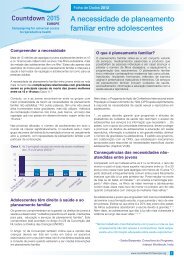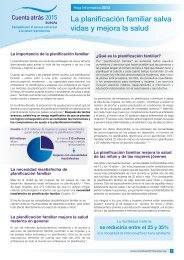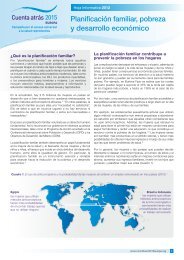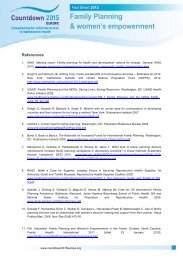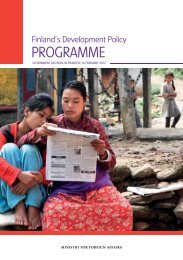The Unmet Need for Family Planning - Countdown 2015 Europe
The Unmet Need for Family Planning - Countdown 2015 Europe
The Unmet Need for Family Planning - Countdown 2015 Europe
Create successful ePaper yourself
Turn your PDF publications into a flip-book with our unique Google optimized e-Paper software.
8. Cut-and-paste tables, graphs and chartsLevel of unmet need among married women indeveloping countries*645 million usecontraception*Most available data on unmet need focus on married or co-habitingwomen and rarely on unmarried women or adolescent girls. Thus figuresare likely to underestimate unmet need.Source: Singh S. , J. Darroch, et al. (2012) Adding It Up: Costs and Benefitsof Contraceptive Services – Estimates <strong>for</strong> 2012. New York: GuttmacherInstitute and United Nations Population Fund (UNFPA); RHSC (2009) Makea Case <strong>for</strong> Supplies, Leading Voices in Securing Reproductive HealthSupplies: An Advocacy Guide and Toolkit. Brussels: Reproductive HealthSupplies Coalition.Unintended pregnancies and births in developingcountriesMillions80706050403020100UnplannedbirthsCurrentlyat least 222 million arenot using any <strong>for</strong>m ofmodern contraceptionwomenwith unmet needUnintendedpregnancies2/3reduction70%reductionIf unmet need were met(projected)<strong>Unmet</strong> need <strong>for</strong> family planning by region*3025 24.2%<strong>2015</strong>109.2%10.5%50Sub-SaharanAfricaAsia Latin America& Caribbean%*Most available data on unmet need focus on married or co-habitingwomen and rarely on unmarried women or adolescent girls. Thus figuresare likely to underestimate unmet need. And while the actual number ofwomen with an unmet need is largest in Asia, the proportion of womenwith unmet need is largest in sub-Saharan Africa, where contraceptiveuse is low.Source: UNPFA 2009% of women ages 15-49Contraceptive prevalence in developing regions1965–2005504540353025<strong>2015</strong>105030 million users430 million users1965 Year 2005Source: Speidel, J., S. Sinding et al. (2009) Making the Case <strong>for</strong> USInternational <strong>Family</strong> <strong>Planning</strong> Assistance. Baltimore, Maryland: JohnsHopkins Bloomberg School of Public Health, Bill and Melinda GatesInstitute <strong>for</strong> Population and Reproductive Health.Status of family planningSource: Singh S. , J. Darroch, et al. (2012) Adding It Up: Costs andBenefits of Contraceptive Services – Estimates <strong>for</strong> 2012. New York:Guttmacher Institute and United Nations Population Fund (UNFPA). www.guttmacher.org/pubs/AIU-2012-estimates.pdfwww.countdown<strong>2015</strong>europe.org31








